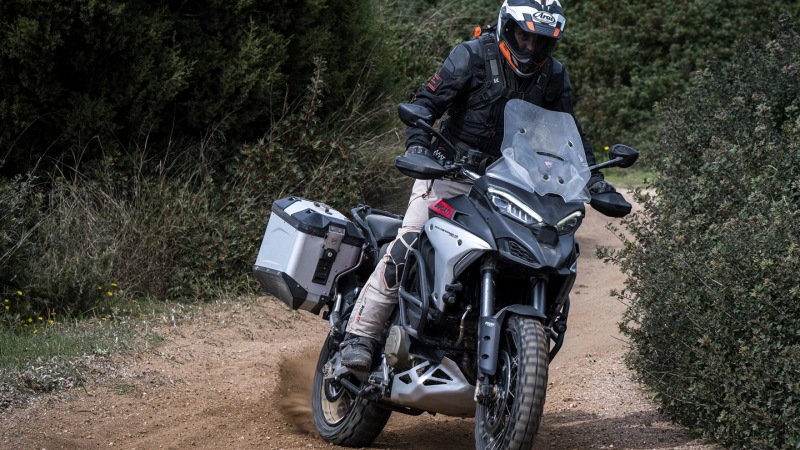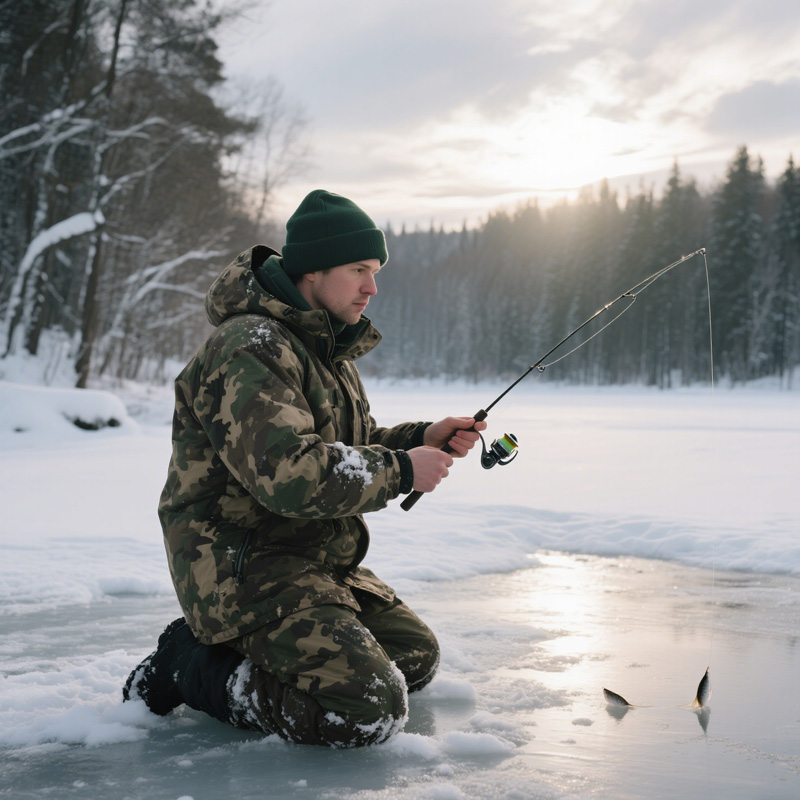A duck hunting vest is a specialized piece of clothing designed for waterfowl hunters.It enhances the hunter’s effectiveness and safety by providing camouflage, warmth, mobility, and easy access to necessary equipment while hunting in often challenging environments.
BOWINS Garment, as an experienced duck hunting clothes manufacturer, provides professional duck hunting vests for enthusiasts through in-depth exploration and understanding of duck hunting activities in different regions. Let us offer some feasible suggestions for the choosing of duck hunting vests.
1. What Is Duck Hunting?
Duck hunting is the practice of hunting ducks for sport, food, or conservation purposes. It is a popular activity in many parts of the world, especially in areas where duck populations are abundant and where hunting is managed sustainably to ensure long-term ecological balance.
Duck hunting combines skill, strategy, and a deep understanding of waterfowl behavior, making it a challenging and rewarding activity. It can also foster a greater appreciation for wildlife and support conservation efforts.
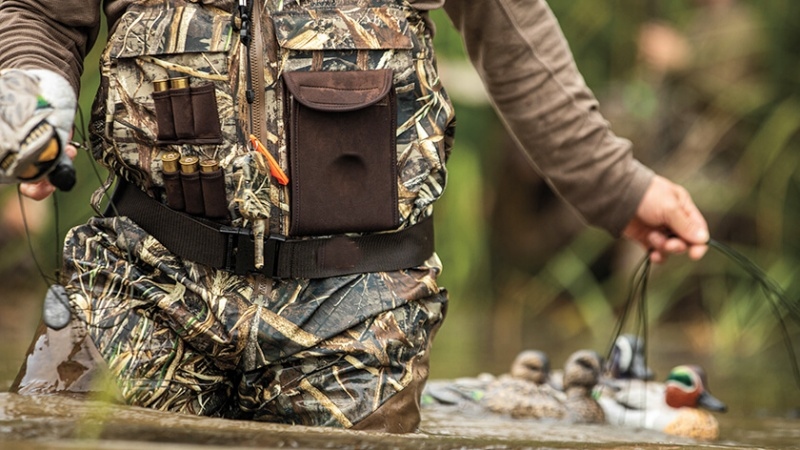
2. What Is Duck Hunting Vest?
A duck hunting vest is a specialized piece of outdoor clothing designed specifically for waterfowl hunters. The vest is engineered to enhance the hunter’s comfort, mobility, and effectiveness in the field while providing utility for carrying essential gear and supplies..
2.1 Camouflage Patterns
Designed with camouflage patterns that mimic common waterfowl environments (like marshes, reeds, or wetlands) to help the hunter blend in and remain undetected by ducks.
2.2 Durable and Water-Resistant Materials
Made from sturdy, water-resistant, or waterproof materials such as neoprene, nylon, or polyester to protect against wet, muddy, and harsh outdoor conditions.
2.3 Insulation
Some vests are insulated to provide warmth in cold weather, which is especially important during early morning or winter hunting.
2.4 Pockets and Storage
Equipped with multiple pockets of various sizes for storing gear like ammunition (shotgun shells), duck calls, snacks, and other essentials. Pockets are typically easy to access and may have secure closures to keep contents dry.
2.5 Game Pouch
A large game pouch or compartment, usually located at the back of the vest, designed for carrying harvested ducks or other small game.
2.6 Mobility and Comfort
Lightweight design with adjustable straps, breathable materials, and a tailored fit to allow freedom of movement for shooting, retrieving, and other activities. Some vests have reinforced padding on the shoulders for added comfort while carrying shotguns or heavy gear.
2.7 Safety Features
Some vests come with built-in flotation panels or buoyancy aids for extra safety if the hunter falls into deep water. Reflective elements may be included to improve visibility in low-light conditions.
2.8 Reinforced Durability
Features such as reinforced stitching, abrasion-resistant fabric, and padded areas are added for durability to withstand tough outdoor environments.
2.9 Accessory Attachments
D-rings, loops, or clips for attaching extra gear like decoys, whistles, or dog leashes, keeping these tools within easy reach.
2.10 Ventilation
Mesh panels or breathable materials in certain areas to allow ventilation and prevent overheating, especially during physically demanding activities or warmer weather.
2.11 Weight Distribution
Designed to evenly distribute the weight of the gear across the body, reducing fatigue and making it easier to carry heavy loads over long distances.
2.12 Quick Access Features
Zippered or magnetic closures for quick and silent access to gear, ensuring minimal noise and movement that might alert ducks.
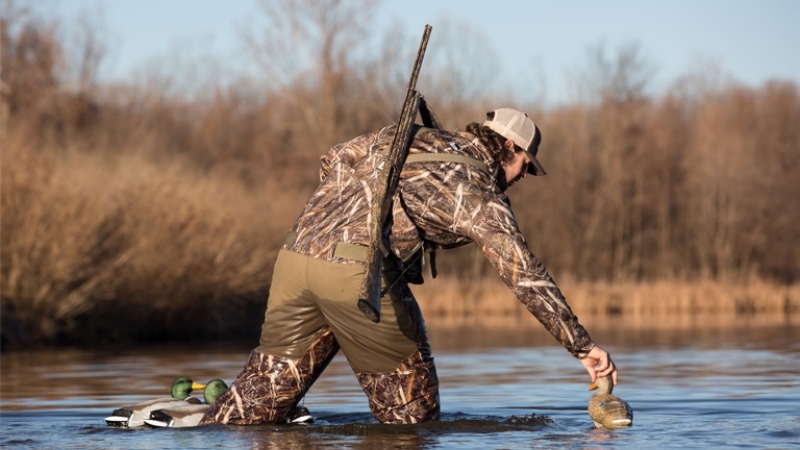
3. What Are Advantages of DuckHunting Vest?
A duck hunting vest offers several advantages for waterfowl hunters, enhancing their experience, safety, and effectiveness in the field. Here are the main benefits
3.1 Organized Gear Storage
A duck hunting vest provides multiple pockets and compartments specifically designed for storing essential gear, such as ammunition, duck calls, decoys, and snacks. This keeps everything organized and within easy reach, reducing the need to search for items and allowing hunters to stay focused.
3.2 Protection Against the Elements
Constructed from durable, water-resistant, or waterproof materials, the vest provides protection against wet, cold, and windy conditions. Some vests offer insulation to help keep the hunter warm, particularly during early morning hunts or in cold weather.
3.3 Convenient Game Carrying
Most vests feature a game pouch or large compartment on the back for carrying harvested ducks or other small game, allowing hunters to keep their hands free for other tasks, like navigating difficult terrain or handling a dog.
3.4 Balanced Weight Distribution
The vest is designed to distribute the weight of the gear evenly across the body, reducing fatigue and discomfort. This is particularly beneficial when carrying heavy loads over long distances or during extended hunts.
3.5 Versatility
Duck hunting vests can be worn in a variety of weather conditions, from early-season hunts to colder months. The versatile design allows them to be layered over or under other clothing as needed.
3.6 Additional Attachment Points
Features like D-rings, loops, or clips allow hunters to attach additional gear, such as decoy bags, whistles, dog leashes, or other accessories, keeping them within easy reach and reducing the need to carry extra bags.
3.7 Reduces Noise
The materials used in duck hunting vests are often designed to be quiet, minimizing noise from fabric rustling or gear movement that could alert ducks to the hunter’s presence.
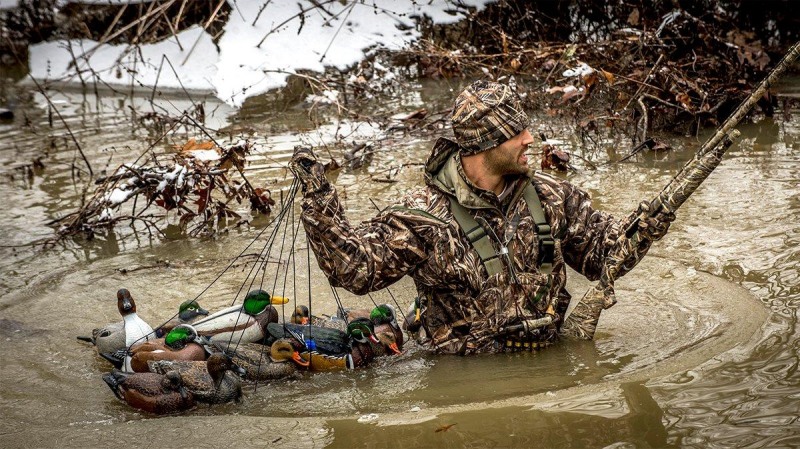
4. How To Choose Right Duck Hunting Vest?
Choosing the right duck hunting vest is crucial for ensuring comfort, safety, and effectiveness in the field. Here are some key factors to consider when selecting a vest:
4.1 Camouflage Pattern
Select a Pattern that Matches Your Hunting Environment: Choose a vest with a camouflage pattern that matches the habitat where you hunt, such as marshes, reeds, open water, or flooded timber. This helps you blend in with your surroundings and remain undetected by ducks.
4.2 Material
Water-Resistant or Waterproof Fabric: Look for materials like neoprene, nylon, or polyester that provide water resistance or are fully waterproof. This is essential for protecting against wet conditions, rain, or water splashes.
Durability: Choose a vest made from tough, abrasion-resistant fabric that can withstand rugged terrain and frequent use. Reinforced stitching and padded areas add to the vest’s durability.
Insulation: If you hunt in colder weather, consider a vest with built-in insulation to help keep you warm. Alternatively, a lighter vest is preferable for early-season or warmer hunts.
4.3 Comfort and Fit
Adjustable Features: Look for adjustable straps, waistbands, or buckles that allow you to customize the fit to your body size and shape. A snug, well-fitted vest will be more comfortable and won’t shift or get in the way while you move.
Breathability: Opt for a vest with breathable materials or mesh panels to allow air circulation and prevent overheating, especially during active hunts or in warmer weather.
Padding: Consider padded shoulder straps if you carry heavy gear or a shotgun for long periods to reduce strain and discomfort.
4.4 Storage Capacity
Pockets and Compartments: Choose a vest with enough pockets and compartments to store all your essential gear, such as ammunition, duck calls, snacks, and personal items. Look for waterproof or zippered pockets to keep valuables dry and secure.
Game Pouch: If you plan to carry harvested ducks or small game, ensure the vest has a large, easily accessible game pouch.
4.5 Safety Features
Buoyancy or Flotation: If you hunt in deep water or from a boat, consider a vest with built-in flotation panels or buoyancy aids for added safety in case you fall into the water.
Reflective Elements: Vests with reflective strips or materials can enhance visibility in low-light conditions, making it easier for other hunters or boats to spot you.
4.6 Ease of Movement
Lightweight and Flexible Design: Choose a vest that allows a full range of motion for shooting, paddling, or handling gear. It should be lightweight and not restrict your movements, ensuring you stay agile and comfortable throughout the hunt.
4.7 Additional Features
Accessory Attachments: Look for D-rings, loops, or clips for attaching extra gear like decoys, whistles, or dog leashes.
Silent Closures: Consider vests with magnetic or quiet zippered closures to minimize noise when accessing gear, which could scare off ducks.
4.8 Weather Suitability
Versatility: If you hunt in varying conditions, consider a vest that can be layered over or under other clothing. A versatile vest can be used in different weather scenarios throughout the hunting season.
4.9 Brand and Reviews
Reputation and Quality: Choose vests from reputable outdoor or hunting brands known for quality and durability. Reading customer reviews and seeking recommendations from experienced hunters can provide insights into the vest’s performance in real-world conditions.
4.10 Budget
Price vs. Features: Set a budget and look for a vest that offers the best combination of features within your price range. While investing in a high-quality vest might cost more initially, it often pays off in terms of durability, comfort, and functionality.
5. Conclusion
Duck hunting vests are specifically designed for hunting ducks for sport, food, or conservation purposes They offer durability,accessory attachments,ventilation,quick access features,. These vests provide hunters with multiple benefits, including distribution,versatility,additional attachment points,and reducing noise.
When selecting duck hunting vests, it’s very important to consider factors such as camouflage pattern,material,comfort and fit,storage capacity,safety features,ease of movement,additional features,weather suitability,brand and reviews,budget.Any questions or inquiries, please contact us.


